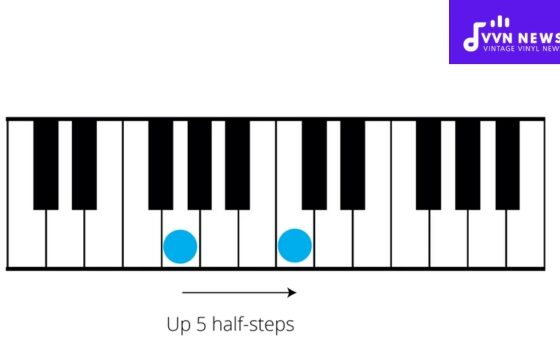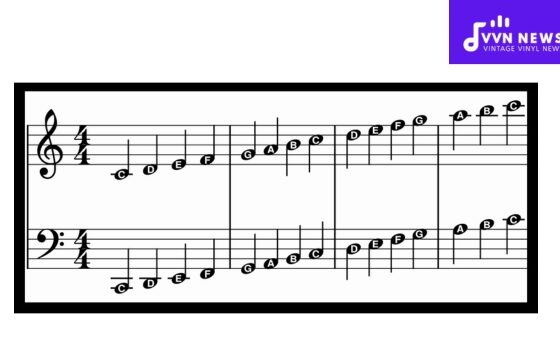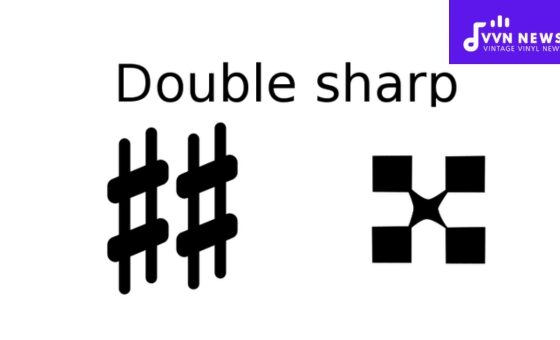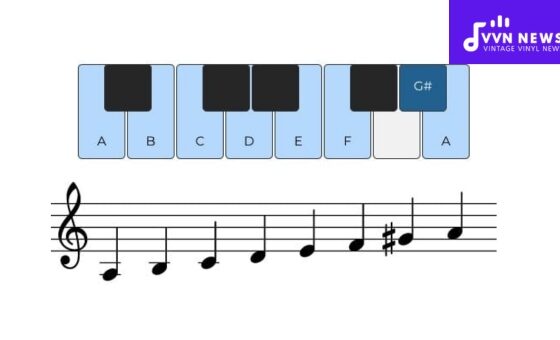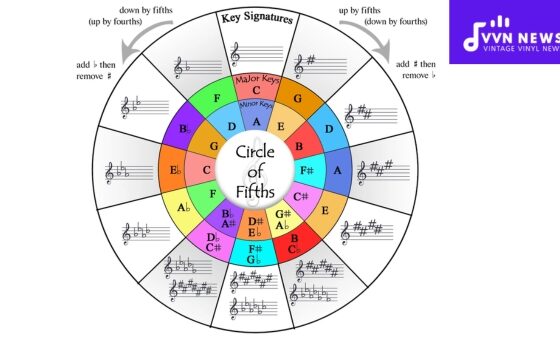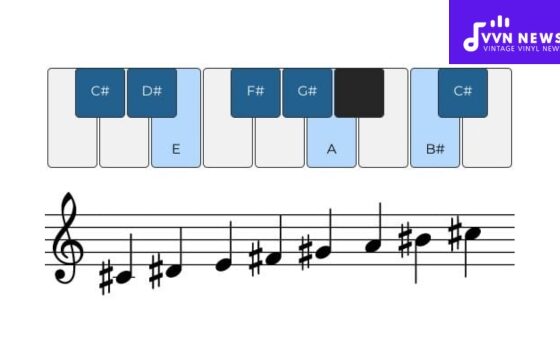There’s a certain charm and versatility to G Major that most musicians can’t help but fall in love with.
The smooth transitions, the harmonious flow, and the gentle rhythm truly make it one of the most popular keys in Western music.
So, it’s about time we get into G major scales and chords.
Delving into musical scales can be a tough task, especially when you’re just starting.
These fundamental building blocks like G Major can significantly enhance your music creation processes.
From strengthening your playing skills to broadening your melodic and harmonic know-how—grasping this simple yet complex key could be your stepping stone into a whole new musical world.
How do you play G Major on different instruments?
There is a certain universal language when it comes to playing scales on various instruments.
The G Major scale, in this case, speaks volumes about this mutuality.
On the Piano
For piano players, G Major is an excellent place to develop your skills. Begin with the root note of ‘G’ on the keyboard.
Follow this with ‘A’, continue to ‘B’, then move to ‘C’. From there, proceed onto ‘D’, ‘E’, then ‘F#’, before coming back round to ‘G’.
The fingering for the G Major scale typically starts with the thumb (1), then pointer finger (2), middle finger (3), thumb under (1), followed by all five fingers – this sounds a lot like: 1, 2, 3, 1, 2, 3, 4, 5!
On the Guitar
While steeped in richer dynamics and string complexities than a piano, translating G major to a guitar still maintains similar principles.
Starting with the open note or open string gives us our first ‘G’. Follow this by pressing down on the second fret of that same string for your ‘A’ and so forth; traverse along frets and strings to unravel that beautiful scale.
On a Flute
Wind instruments like flutes or recorders remain faithful to the universality of scales.
Their sound is defined not by strings or keys but by airflow and apertures. To play G Major here, start from low G; follow through A-B-C-D-E-F#, ending on high G.
These fundamentals persist even as we expand across several other instruments – whether it’s something harmonic such as a harp or various brass organs like trumpets or saxophones._
The beauty of music theory lies in its capability to be applied across an array of instruments rendering endless emotional landscapes.
So, run those scales, explore that tonal space, and craft your musical nodes; who knows – you just might be orchestrating the next brilliant symphony.
Also Read: C Sharp Major Pentatonic Scale [Crisp & Clear Tones For Your Music]
Key Signature Details of G Major

The key signature of G Major holds an important place in its unique identity. It has one sharp: F#.
This single sharp is a definer, setting the stage for an exciting musical journey in this vibrant and dynamic key.
The layout of notes in a major scale always follows the pattern: whole, whole, half, whole, whole, whole, half. In terms of the G Major scale specifically:
- G – A (whole)
- A – B (whole)
- B – C (half)
- C – D (whole)
- D – E (whole)
- E – F#(whole)
- F#- G (half)
This pattern provides you with the blueprint to figure out the specific pitches in each octave that make up this beautiful key.
This straightforward structure will be your essential tool when journeying through compositions using this scale.
The Fundamental Chords in G Major
The G Major key is defined by its core chords that make up this unique scale.
These primary chords are built from each degree of the scale and labeled as I, ii, iii, IV, V, vi, and vii.
- G Major (I): In the heart of this key resides the G major chord itself. This tonic chord consists of the notes G, B, and D.
- A minor (ii): The subdominant or second degree is A minor. It carries the notes A, C, and E.
- B minor (iii): The third degree or mediant is B minor and comprises B, D, and F#.
- C Major (IV): The subdominant part on the fourth degree manifests in the form of the chord C major which encompasses C, E, and G.
- D Major (V): As for dominant—the fifth degree—is expressed by D major that entails D, F#, A
- E minor (vi): Playing on your heartstrings with melancholy is E minor as submediant—the sixth degree—that bursts with E, G, and B.
- F# diminished (vii°): Lastly, the leading tone—the seventh degree—is captured by F# diminished providing an edgy feel with F#, A, C.
The three major chords are G Major(I), C Major(IV) & D Major(V).
Three minor chords are A minor(ii), B minor(iii) & E minor(vi). And as for a dash of tension amidst harmony, the diminished chord serves with F#(vii).
These chords form the backbone of countless songs within several genres.
As you master these structures in the G Major key, you delve deeper into musical complexities while maintaining harmony.
Also Read: How To Transpose Into The Tenor Clef? [Mastering In Notation]
G Major Scale Representation in Various Clefs

Before embarking on a musical journey characterized by G Major scales and chords, it’s essential to grasp how this scale manifests itself across various clefs—the symbols used to identify how high or low the notes are on a staff. And that’s exactly what we’ll do in this section.
Treble Clef
In the treble clef, which is also known as the G clef due to its swirl encircling the “G” line, the G Major scale starts from G on the second bottom line.
Ascending, we pass through A, B, C, and D notes until reaching E sitting snugly on the top line.
Now, bear in mind that not all of these notes are confined simply to lines but jump around between spaces as well.
Bass Clef
When we shift to bass clef or F clef territory – chosen for lower-pitched instruments like bass guitars and cellos – matters take a slightly different turn.
Although it’s still focused around our beloved G-A-B-C-D-E timeline it unfolds from the third line from up.
Alto Clef
Often overlooked but just as important is the alto clef, typically represented by its signature snake-like symbol.
Here’s where you’ll find violists deeply engrossed with their instruments—the alto clef reigns supreme.
The scale begins with G symmetrically placed in the middle of the staff trailing upwards into musical infinity.
Tenor Clef
Last but not least comes the tenor clef used predominantly by bassoonists and trombone players for higher ranges.
Just like its alto brother above, our friend ‘G’ is right in equilibrium while venturing out both ways on its musical quest.
Each of these differing presentations of our star-studded G Major scale provides unique insights into how music can be perceived differently depending upon one’s instrument of choice.
As these melodious structures unfurl themselves across the grand staff, they form a beautiful symphony of notes that we’ve come to know and love as the G Major scale.
Also Read: Transpose Bass Clef To Treble Clef [How To Guide & Tips]
Comparing G Major with Other Major Scales
At first glance, all major scales might seem similar. They share the same pattern and structure – a succession of whole and half steps.
Each one has its own unique set of characteristics that we should consider.
G Major vs C Major
Comparatively speaking, C Major is often considered one of the easiest scales to play because it consists entirely of white keys on a piano.
On the contrary, G Major introduces the first sharp note (F#) into its composition. This allows for a richer, deeper sound than provided by C Major.
G Major vs D Major
When turned towards D major, which contains two sharps (F# and C#), G major offers simplicity yet depth in its scale.
Musicians often perceive it as being brighter or more joyful than the less complex D scale.
G Major vs E Major
Next up, E major consists of four sharps yielding a vibrant and full-bodied melodic theme.
If you compare this to G major’s single sharp, you may find G major to be smoother with a less intense tonal complexity.
With these comparisons between G major and other scales, you can appreciate their differences in harmonious blending while improvising at your instruments.
Famous tracks that use G Major

In the magical realm of music, G Major has made its renowned presence in countless famous tracks, leaving an indelible mark on our hearts.
From legendary artists to contemporary virtuosos, let’s dive into some of these unforgettable melodies in G Major.
1. Johann Sebastian Bach: “Minuet in G”
Bach’s masterpiece stands as a testament to the depth and versatility of G Major. The song beautifully highlights the musical possibilities within this key signature, exploring a variety of chordal relationships and progressions.
2. Johann Pachelbel: “Canon in D”
Despite its title, Pachelbel’s Canon is often played in G Major for easier fingering on most instruments.
Displaying an array of chords found within this key, it is an exquisite piece that introduces musicians to a wide scope of harmonic interactions within the scale.
3. The Beatles: “Here Comes The Sun”
Arguably one of The Beatles’ most loved tracks, ‘Here Comes The Sun’ showcases a delightful exploration of the key through its simple but effective guitar-driven melody and harmonious vocal lines.
4. Bruno Mars: “Just The Way You Are – Piano Version”
The Piano Version of this hit song splendidly exhibits the G Major scale by Bruno Mars himself on piano, establishing how the simple and sweet sound from this key can generate emotions and atmospheres.
5. Ed Sheeran’s infamous track
“Shape Of You” uses a looping pedal and capo adjustments to turn E minor into the pivotal point; its dominant is B major which means it still fits into our brilliant G Major realm!
These well-known tunes underline how beautifully diverse melodies can be derived from what might seem a relatively straightforward scale arrangement at first glance—G Major.”
Tackling these songs with your newly acquired knowledge should enhance your confidence while discovering more about the profound possibilities concealed within this amazing scale.
Also Read: Bass Clef [Understanding This Essential Music Symbol]
FAQs About The G Major scale
What is the main difference between the G Major scale and the G minor scale?
The major difference between these two scales lies in the third note. In a G Major scale, it’s a B, making it sound happy or bright. In contrast, a G minor has a Bb, giving it a moody or sorrowful tone.
How does key signature of G Major look like on sheet music?
In sheet music notation, the key signature of G major is denoted by one sharp (F#) placed on the staff.
What are some simple chords to begin with in G Major for a beginner?
A novice can easily begin with some primary triad chords in G Major, which include G major (G-B-D), C major (C-E-G), and D major (D-F#-A).
Why is understanding chord progression important for playing in G Major?
Recognizing chord progression gives you insight into the pattern and structure of music. It helps you understand how chords flow together rhythmically in a melody specifically when composing or improvising music in keys like G Major.
Can you mention one famous song that uses G Major extensively?
A classic example of songs rendered beautifully in this scale is “Brown Eyed Girl” by Van Morrison featuring characteristics of a typical progression in G Major.
Conclusion
In conclusion, the G Major scale and its chords are essential for anyone wanting to enhance their musical prowess.
Not only will it expand your playing skills, but it will also give you a greater appreciation for the harmonic potential of music itself.
From your key signature details, and chord creations, to typical progressions—each aspect contributes to increasing your musical versatility.
So open up to G Major, and unlock new melodies and harmonies because at the end of it all, mastering this scale could be your gateway into an entirely new realm of creativity.

